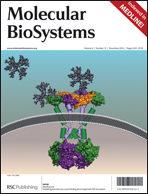Cancer is an intrinsically heterogeneous disease. Tumors classified under the same etiology and histological type may display divergent growth and invasion properties, resulting in different progression rates and clinical outcomes. Here, we approached this subject in a syngeneic mouse model of ovarian cancer. Antibody microarrays were applied to obtain the proteomic profiles of IF5 and IG10, two spontaneously transformed mouse ovarian surface epithelial (MOSE) cell lines of cognate clonal origin but different tumorigenic behavior in vivo. Repeated dye-swap allowed filter out about 40% of inconsistent signals from a total of 224 arrayed antibodies. Two-class comparison tests resulted in 31 differentially expressed proteins (adjusted p < 0.05). Proteins of the ErbB and focal adhesion signaling pathways showed higher levels in IG10, the most aggressive cell. In contrast, the less aggressive IF5 cell was enriched in proteins related to nuclear chromatin organization and cell-cycle. Additionally, comparison between protein levels and mRNA levels of MOSE cells resulted in a positive rank correlation for 50–60% of protein–mRNA pairs (p < 1.7 × 10−5). Importantly, the protein profile of IG10 is linked to invasion and chemotherapy response in human ovarian tumors while the IF5 profile is associated to growth control. The minimal IG10 network contained the proteins Jun, Smad4, Myc, Atf2, and Pak1 as major nodes while Chek2, Mdm2 and Ccna2 were the predominant nodes of the IF5 network. The molecular basis accounting for a high aggressive potential not necessarily related to an increased tumor growth capacity is discussed on a pathway-network basis.

You have access to this article
 Please wait while we load your content...
Something went wrong. Try again?
Please wait while we load your content...
Something went wrong. Try again?


 Please wait while we load your content...
Please wait while we load your content...